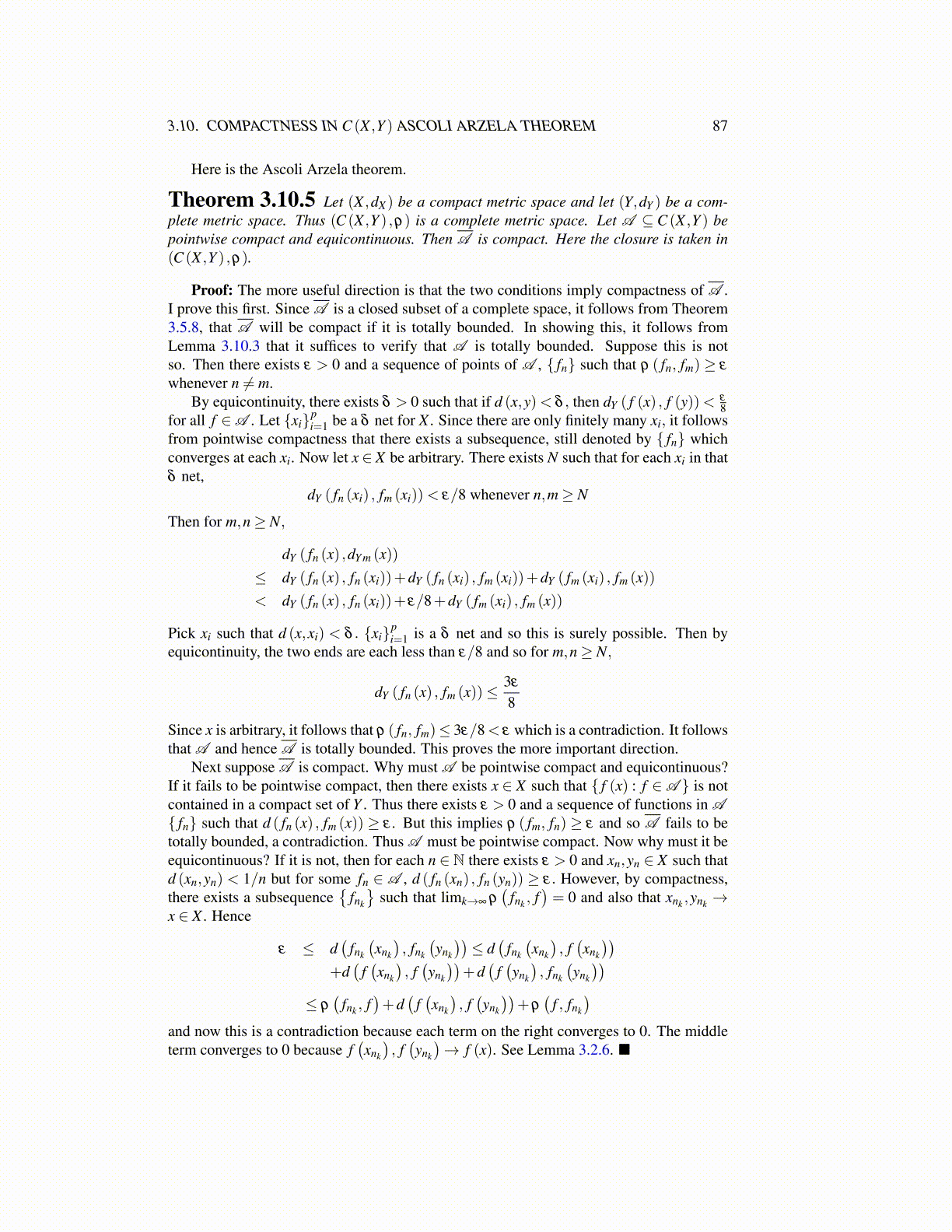
3.10. COMPACTNESS IN C (X ,Y ) ASCOLI ARZELA THEOREM 87
Here is the Ascoli Arzela theorem.
Theorem 3.10.5 Let (X ,dX ) be a compact metric space and let (Y,dY ) be a com-plete metric space. Thus (C (X ,Y ) ,ρ) is a complete metric space. Let A ⊆ C (X ,Y ) bepointwise compact and equicontinuous. Then A is compact. Here the closure is taken in(C (X ,Y ) ,ρ).
Proof: The more useful direction is that the two conditions imply compactness of A .I prove this first. Since A is a closed subset of a complete space, it follows from Theorem3.5.8, that A will be compact if it is totally bounded. In showing this, it follows fromLemma 3.10.3 that it suffices to verify that A is totally bounded. Suppose this is notso. Then there exists ε > 0 and a sequence of points of A , { fn} such that ρ ( fn, fm) ≥ ε
whenever n ̸= m.By equicontinuity, there exists δ > 0 such that if d (x,y)< δ , then dY ( f (x) , f (y))< ε
8for all f ∈A . Let {xi}p
i=1 be a δ net for X . Since there are only finitely many xi, it followsfrom pointwise compactness that there exists a subsequence, still denoted by { fn} whichconverges at each xi. Now let x ∈ X be arbitrary. There exists N such that for each xi in thatδ net,
dY ( fn (xi) , fm (xi))< ε/8 whenever n,m≥ N
Then for m,n≥ N,
dY ( fn (x) ,dY m (x))
≤ dY ( fn (x) , fn (xi))+dY ( fn (xi) , fm (xi))+dY ( fm (xi) , fm (x))
< dY ( fn (x) , fn (xi))+ ε/8+dY ( fm (xi) , fm (x))
Pick xi such that d (x,xi) < δ . {xi}pi=1 is a δ net and so this is surely possible. Then by
equicontinuity, the two ends are each less than ε/8 and so for m,n≥ N,
dY ( fn (x) , fm (x))≤ 3ε
8
Since x is arbitrary, it follows that ρ ( fn, fm)≤ 3ε/8< ε which is a contradiction. It followsthat A and hence A is totally bounded. This proves the more important direction.
Next suppose A is compact. Why must A be pointwise compact and equicontinuous?If it fails to be pointwise compact, then there exists x ∈ X such that { f (x) : f ∈A } is notcontained in a compact set of Y . Thus there exists ε > 0 and a sequence of functions in A{ fn} such that d ( fn (x) , fm (x)) ≥ ε . But this implies ρ ( fm, fn) ≥ ε and so A fails to betotally bounded, a contradiction. Thus A must be pointwise compact. Now why must it beequicontinuous? If it is not, then for each n ∈ N there exists ε > 0 and xn,yn ∈ X such thatd (xn,yn) < 1/n but for some fn ∈ A , d ( fn (xn) , fn (yn)) ≥ ε. However, by compactness,there exists a subsequence
{fnk
}such that limk→∞ ρ
(fnk , f
)= 0 and also that xnk ,ynk →
x ∈ X . Hence
ε ≤ d(
fnk
(xnk
), fnk
(ynk
))≤ d
(fnk
(xnk
), f(xnk
))+d(
f(xnk
), f(ynk
))+d(
f(ynk
), fnk
(ynk
))≤ ρ
(fnk , f
)+d(
f(xnk
), f(ynk
))+ρ
(f , fnk
)and now this is a contradiction because each term on the right converges to 0. The middleterm converges to 0 because f
(xnk
), f(ynk
)→ f (x). See Lemma 3.2.6. ■